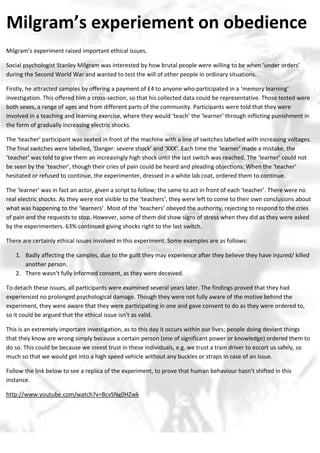
Milgram's experiment
- 1. Milgram’s experiement on obedience Milgram’s experiment raised important ethical issues. Social psychologist Stanley Milgram was interested by how brutal people were willing to be when ‘under orders’ during the Second World War and wanted to test the will of other people in ordinary situations. Firstly, he attracted samples by offering a payment of £4 to anyone who participated in a ‘memory learning’ investigation. This offered him a cross-section, so that his collected data could be representative. Those tested were both sexes, a range of ages and from different parts of the community. Participants were told that they were involved in a teaching and learning exercise, where they would ‘teach’ the ‘learner’ through inflicting punishment in the form of gradually increasing electric shocks. The ‘teacher’ participant was seated in front of the machine with a line of switches labelled with increasing voltages. The final switches were labelled, ‘Danger: severe shock’ and ‘XXX’. Each time the ‘learner’ made a mistake, the ‘teacher’ was told to give them an increasingly high shock until the last switch was reached. The ‘learner’ could not be seen by the ‘teacher’, though their cries of pain could be heard and pleading objections. When the ‘teacher’ hesitated or refused to continue, the experimenter, dressed in a white lab coat, ordered them to continue. The ‘learner’ was in fact an actor, given a script to follow; the same to act in front of each ‘teacher’. There were no real electric shocks. As they were not visible to the ‘teachers’, they were left to come to their own conclusions about what was happening to the ‘learners’. Most of the ‘teachers’ obeyed the authority, rejecting to respond to the cries of pain and the requests to stop. However, some of them did show signs of stress when they did as they were asked by the experimenters. 63% continued giving shocks right to the last switch. There are certainly ethical issues involved in this experiment. Some examples are as follows: 1. Badly affecting the samples, due to the guilt they may experience after they believe they have injured/ killed another person. 2. There wasn’t fully informed consent, as they were deceived. To detach these issues, all participants were examined several years later. The findings proved that they had experienced no prolonged psychological damage. Though they were not fully aware of the motive behind the experiment, they were aware that they were participating in one and gave consent to do as they were ordered to, so it could be argued that the ethical issue isn’t as valid. This is an extremely important investigation, as to this day it occurs within our lives; people doing deviant things that they know are wrong simply because a certain person (one of significant power or knowledge) ordered them to do so. This could be because we invest trust in these individuals, e.g. we trust a train driver to escort us safely, so much so that we would get into a high speed vehicle without any buckles or straps in case of an issue. Follow the link below to see a replica of the experiment, to prove that human behaviour hasn’t shifted in this instance. http://www.youtube.com/watch?v=BcvSNg0HZwk